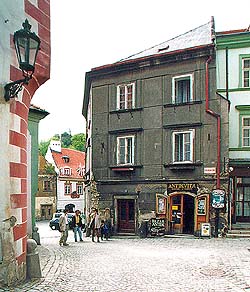Soukenická No. 33
Description of the Building:
A two-storey building with an irregular outline of the outer perimeter with a facade divided by six axes, newly adapted and covered with Břízolit surface (Břízolit - a sort of material used for facades) in 1929 or so, without a deep articulation.
Architectural and Historical Development:
The building of medieval origin (the cellars probably come from that time) was notably rebuilt in the Rennaissance period. There are interiors with ridged vaults on the ground floor and the first floor. In the Baroque age there was a new staircase built in the central section. The most recent reconstruction was carried out in the 20th century.
Significant Architectural Features:
Cellars - partly excavated in the rock sole, in the back yard a well has been preserved, a simple molded entrance portal with the date of 1670 on it, and the Rennaissance joist ceiling with a huge girder with decorations in the shape of plaits is situated in the back section of the ground floor. Decorative framing of walls with stripes from the Rennaissance period and ridged vaults were also found there.
History of the House Residents:
Filip Rott is mentioned as the first owner of the house in 1582. He was followed by Kryštof Hain. In 1621 a baker Matyáš Hölzel moved there and probably owned the house until 1661, followed by a merchant Matyáš Pittner. A merchant Jan Pittner stayed in the house in the years 1665 - 1704 and later on a horse-dealer Jan Pauer. In 1727 a royal gunpowder master Kristián Casian became a new owner of the house. From 1766 a baker Vojtěch Tuschl lived there and the house was a bakery after 1792 under Filip Anderle and after 1929 under Hermína Fuchs.
Present Use:
M & G Goldsmith, Hotel Leonardo


